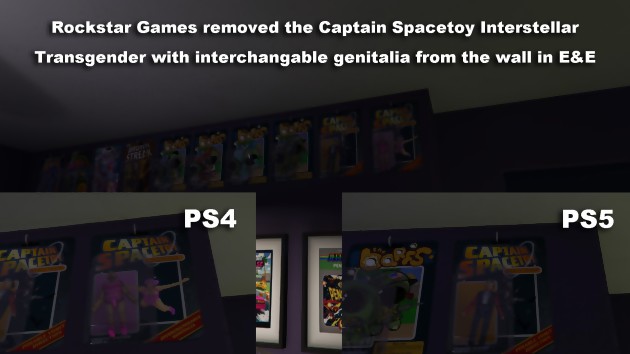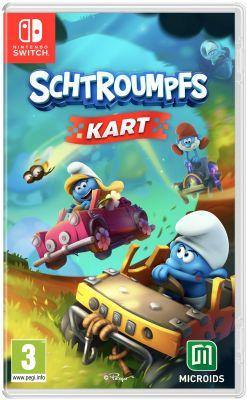 Fictional skating sport requires, let's start this review of the game with a small description of the rules. The games are played three against three, on an oval circuit equipped with a single goal (circular and high placed) in which to send the ball. By default this circle is closed, and it is necessary to activate four virtual gates located along the circuit to open it and be able to score. Each time a team recovers the ball the door counter is reset, so that it is not possible to take advantage of the work done by the opponents. Conversely, if the same team completes several laps of the circuit before throwing the ball into the goal, it then scores more points. A goal equals one point after one round, three points after two rounds, and five points after three rounds. Knowing that the first team to score five points immediately wins the match, it is tempting to keep the ball for several rounds… at the risk of having it stung after a well-placed tackle. This is one of the first subtleties of the game, which also rewards daring players who suddenly change direction, whether to reach a door more quickly, to surprise opponents, to get rid of a pursuer, or to place on the other side of the track in relation to the one who holds the ball, in order to receive it as quickly as possible. There is a way to play a very good game, especially when playing with friends, communicating orally, and making as many passes as possible. In addition, the variable score system depending on the number of rounds allows spectacular turnarounds. A team trailing 4 to 1, for example, will have every interest in taking risks and trying to complete three laps, in order to instantly and definitively turn the tide.
Fictional skating sport requires, let's start this review of the game with a small description of the rules. The games are played three against three, on an oval circuit equipped with a single goal (circular and high placed) in which to send the ball. By default this circle is closed, and it is necessary to activate four virtual gates located along the circuit to open it and be able to score. Each time a team recovers the ball the door counter is reset, so that it is not possible to take advantage of the work done by the opponents. Conversely, if the same team completes several laps of the circuit before throwing the ball into the goal, it then scores more points. A goal equals one point after one round, three points after two rounds, and five points after three rounds. Knowing that the first team to score five points immediately wins the match, it is tempting to keep the ball for several rounds… at the risk of having it stung after a well-placed tackle. This is one of the first subtleties of the game, which also rewards daring players who suddenly change direction, whether to reach a door more quickly, to surprise opponents, to get rid of a pursuer, or to place on the other side of the track in relation to the one who holds the ball, in order to receive it as quickly as possible. There is a way to play a very good game, especially when playing with friends, communicating orally, and making as many passes as possible. In addition, the variable score system depending on the number of rounds allows spectacular turnarounds. A team trailing 4 to 1, for example, will have every interest in taking risks and trying to complete three laps, in order to instantly and definitively turn the tide.
JUMPING SKATES
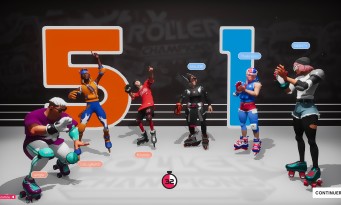 Beyond the rules and the initial concept, if the game works well it is also because it benefits from a good technical realization and a solid gameplay. Getting started is immediate, and actions such as "rolling upside down" or "looking behind you" occur naturally. As for the tutorial, it fulfills its role perfectly since it teaches us the technique of the piston, which allows us to gain speed by squatting on the descents, informs us of the possibility of tackling the opponents to steal the ball from them, and reminds us that the phenomenon of aspiration, which makes it possible to catch up with a "runner" located in front of us, is managed. It is also possible to cling to a teammate in order to benefit from a speed boost when you let go (perfect for catching up with an opponent or positioning yourself as a receiver), to jump, to brake or to achieve dodges. A good compromise between realism and accessibility seems to have been found, which offers both immediate fun and room for improvement. A skatepark is also available for training alone or with others. If the artistic direction is perhaps a bit too generic, the graphics have the advantage of being clean, readable and fluid. And on the audio side, there is also something to celebrate. Thus the music on hold menus form a highly recommendable chill/pop/lounge soundtrack, where Beatrich (Superstar), Diego Power (Lost in your eyes), Grimes (Flesh Without Bloods), Nilüfer Yanya (Sliding Doors) rub shoulders ), Purity Ring (Fineshrine) or The Chainsmokers (Don't Let Me Down). As for the French commentator, he managed the feat of making tons and tons of them without ever being annoying. We are however on the razor's edge at times, because some of his intonations are clearly inspired by other actors and comedians, but the final result passes cream and participates in the dynamism of the matches.
Beyond the rules and the initial concept, if the game works well it is also because it benefits from a good technical realization and a solid gameplay. Getting started is immediate, and actions such as "rolling upside down" or "looking behind you" occur naturally. As for the tutorial, it fulfills its role perfectly since it teaches us the technique of the piston, which allows us to gain speed by squatting on the descents, informs us of the possibility of tackling the opponents to steal the ball from them, and reminds us that the phenomenon of aspiration, which makes it possible to catch up with a "runner" located in front of us, is managed. It is also possible to cling to a teammate in order to benefit from a speed boost when you let go (perfect for catching up with an opponent or positioning yourself as a receiver), to jump, to brake or to achieve dodges. A good compromise between realism and accessibility seems to have been found, which offers both immediate fun and room for improvement. A skatepark is also available for training alone or with others. If the artistic direction is perhaps a bit too generic, the graphics have the advantage of being clean, readable and fluid. And on the audio side, there is also something to celebrate. Thus the music on hold menus form a highly recommendable chill/pop/lounge soundtrack, where Beatrich (Superstar), Diego Power (Lost in your eyes), Grimes (Flesh Without Bloods), Nilüfer Yanya (Sliding Doors) rub shoulders ), Purity Ring (Fineshrine) or The Chainsmokers (Don't Let Me Down). As for the French commentator, he managed the feat of making tons and tons of them without ever being annoying. We are however on the razor's edge at times, because some of his intonations are clearly inspired by other actors and comedians, but the final result passes cream and participates in the dynamism of the matches.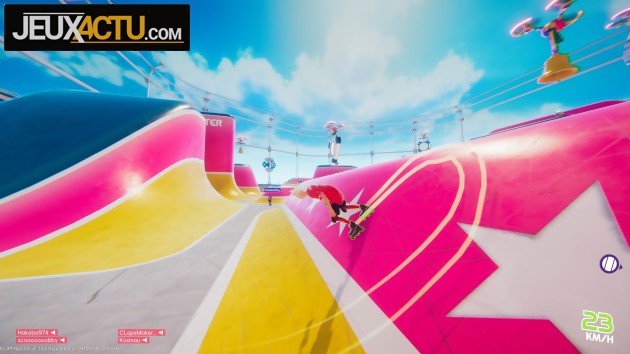
BE CAREFUL NOT TO TURN INTO CIRCLES
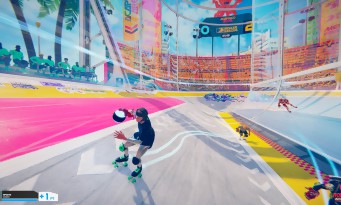 The real point on which Roller Champions can possibly disappoint concerns a certain lack of content. Apart from the main game mode accessible in quick play, there is not much to get your teeth into. Fans of pure competition will certainly be able to participate in ranked games in order to evolve on seven different ranks, but that does not change the rules of the game. For this, we will have to rely on the "surprise events", which should regularly offer new variations, such as 2v2, "hot potato" or "lootball madness". At the time of writing these lines, none of these additional modes is yet available and only time will tell if the publisher manages to keep its schedule. Five seasons are planned for the first year of operation of this game-service, each of which should bring its share of maps, modes, events, mini-games and cosmetic elements. For the time being, for example, there are only three different stadiums to unlock (Acapulco, Mexico City and Chichén Itzá), moreover in a linear fashion. In other words, all your games will initially take place on the same terrain. Likewise, some cosmetic items unlock in a given order. Everyone tends to adopt the same look at the same time. Fortunately, lootboxes renamed lootballs make it possible to obtain random elements and therefore to put a little variety in the teams. These surprise balloons contain 60% ordinary, 30% rare, 7% epic, and 3% legendary level cosmetics. This ultimately allows us to customize the different clothes, hairstyles and poses of our avatar, and even the small goal animations. A store with virtual currency is also available, in the great tradition of free-to-play. Ubisoft can be commended for not offering any competitive advantage to those who open their wallets, but the publisher is not showing extreme generosity either. Thus the Premium Pass allows you to unlock around thirty different elements, against only eleven for the free Pass. We can't have the roller and the money for the roller...
The real point on which Roller Champions can possibly disappoint concerns a certain lack of content. Apart from the main game mode accessible in quick play, there is not much to get your teeth into. Fans of pure competition will certainly be able to participate in ranked games in order to evolve on seven different ranks, but that does not change the rules of the game. For this, we will have to rely on the "surprise events", which should regularly offer new variations, such as 2v2, "hot potato" or "lootball madness". At the time of writing these lines, none of these additional modes is yet available and only time will tell if the publisher manages to keep its schedule. Five seasons are planned for the first year of operation of this game-service, each of which should bring its share of maps, modes, events, mini-games and cosmetic elements. For the time being, for example, there are only three different stadiums to unlock (Acapulco, Mexico City and Chichén Itzá), moreover in a linear fashion. In other words, all your games will initially take place on the same terrain. Likewise, some cosmetic items unlock in a given order. Everyone tends to adopt the same look at the same time. Fortunately, lootboxes renamed lootballs make it possible to obtain random elements and therefore to put a little variety in the teams. These surprise balloons contain 60% ordinary, 30% rare, 7% epic, and 3% legendary level cosmetics. This ultimately allows us to customize the different clothes, hairstyles and poses of our avatar, and even the small goal animations. A store with virtual currency is also available, in the great tradition of free-to-play. Ubisoft can be commended for not offering any competitive advantage to those who open their wallets, but the publisher is not showing extreme generosity either. Thus the Premium Pass allows you to unlock around thirty different elements, against only eleven for the free Pass. We can't have the roller and the money for the roller...





